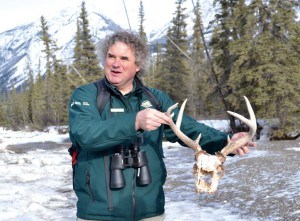
On a snowy patch of trail near the Athabasca River, Jan. 24, a group of about a dozen people peered intently at a pile of wolf scat.
Brian Catto stood next to the droppings, pointing out its intricacies—its consistency, the amount of hair it contained—and what those things could tell the group about the animal’s behaviour.
Catto is a Parks Canada interpreter, and was leading the group on Parks’ Wildlife Trail Camera Safari, which it is offering as part of the Jasper in January suite of events this month.
The interpretive hike takes participants on a short walk through Jasper’s forests, exploring some of the tricks and gadgets researchers use to study wildlife in the park.
The hike started with a short presentation by Catto next to the Sixth Bridge parking lot, where he gave a mini-demonstration of the tracks, bones and dropping of some of the park’s animals.
“Researchers need to see without seeing. They need to read this landscape and learn the stories of the animals that are out there. That’s because the landscape here is like a manuscript where the animals write their story as they pass by,” Catto said.
“An animal that we normally see in places like this,” he said, reaching into his bag and pulling out a gleaming skull, eliciting a few gasps from the group, “is Ms. Elk.”
He also brought out the skulls of a wolf and cougar, talking about how the animals move and live in the park. He also explained how to use “splatter vision” to catch sight of wildlife in peripheral vision.
Catto told the group about how Parks uses GPS tracking collars to keep tabs on certain animals like wolves, and brought out casts of animal tracks people might see in the park.
“With different techniques we can see without seeing as we make our way around the trail today. We can see signs of animals left by tracks, maybe we can see scarring on trees, or other signs,” he said.
After handing out trail guides and tracking manuals, Catto lead the group along the Flower Loop, a two-kilometre hike that leaves from Sixth Bridge, follows the Athabasca River and eventually connects to the Overlander Trail.
Catto pointed out songbirds taking baths in the river, and tracks from passing elk herds, before stopping to show off the skull of a deer on the river’s banks. Hikers stroked its horns with wide eyes, and held it up for selfies, before Catto spurred them on up the trail.
Further along, he stopped the group at one of the automatic cameras Parks had set along the trail to capture wildlife movement in the area. He explained that researchers learn a lot about the movement of wildlife where the cameras are set up.
At the end of the hike, Catto stopped the group on Sixth Bridge, and read a quote from renowned tracker Tom Brown Jr.
“The first track is the end of a string. At the far end a being is moving; a mystery, dropping a hint about itself every so many feet, telling you more about itself until you can almost see it, even before you come to it. The mystery reveals itself slowly, track by track, giving its genealogy early to coax you in. Further on, it will tell you the intimate details of its life and work until you know the maker of the track like a lifelong friend.”
“And people who are very good at tracking, they can do that,” said Catto. “They can see so many little variations. [Other interpreters] can follow a set of tracks and tell you a story of what that animal was thinking,” he continued, explaining that they can tell when an animal stopped, what it stopped for, where it was heading and likely why.
“What all this boils right back down to is simple observation.”
Helena Church and Chris Barfield were on the hike Jan. 24. They hail from England, and said that it was a unique way for them to experience Jasper.
“It’s really interesting, because there’s so much you don’t know about. Lots of people just go and ski, but actually there’s so much here in Jasper, it’s fantastic isn’t it?” Church said.
“I think also, you’re following the trail—I know you need to look where you’re going—but if you look around, it’s fantastic what you see,” Barfield chimed in.
Barfield said it was nice to see the park through the eyes of someone as enthusiastic as Catto.
“I think it’s slightly scary going through the woods. [But] when you go with someone like Brian you get so much more out of it.”
Barfield said he was fascinated to learn about all the different tracks that animals leave, their behaviors and how to spot them.
“I would recommend this to anyone. People should really take some time out and see some of this,” Church said.
Anyone wishing to take Church’s advice is in luck: Parks will offer the interpretive hike again on the final weekend of Jasper in January, and on select occasions later in the year.
To participate, meet at the Totem Pole at 1 p.m. on Jan. 31 or Feb. 1.
